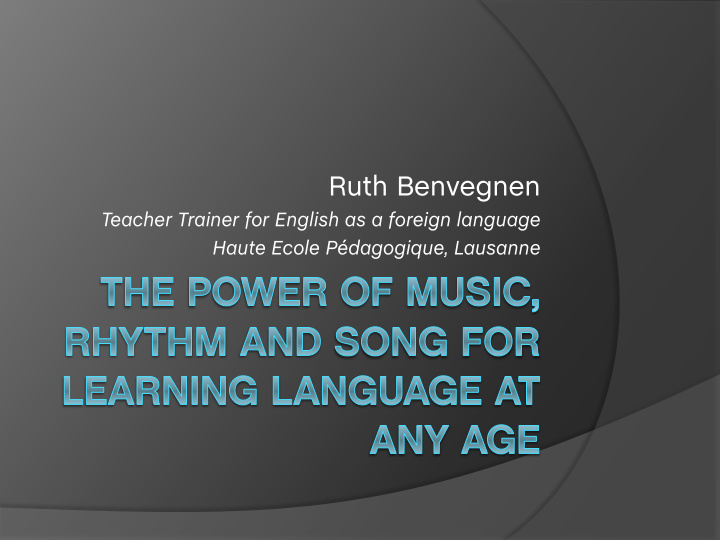



Ruth Benvegnen Teacher Trainer for English as a foreign language Haute Ecole Pédagogique, Lausanne
A gentle start… A short rap / chant to say ‘Hi’
Why is rhythm and music important for learning?
Musical memory Emotional memory Chunks of language Pronunciation Fluency Culture Confidence Autonomy
Rhythm for pronunciation
Can you say these tongue-twisters ? Thirty-three thousand, thundering thoroughbreds thumped Mr Thurber on Thursday * She sells seashells on the sea shore
Songs for culture
Adapting cultural songs Adapting a famous melody/song to make it potentially more useful
The original version - Cultural
Adapted to work on essential low-level vocabulary Monday, Tuesday Monday, Tuesday Wednesday, Thursday Wednesday, Thursday Friday, Whoopee! Saturday, Sunday Saturday, Sunday Created with participants from Carol Bourne and Jacqueline Johnston’s workshop on teaching YLs
Musical memory
Creating easy chants Cr Pupils make a table of three (4?) columns Pupils put lexical words in columns depending on the number of syllables (1, 2, 3, and 4?) Make a chant using the following code: 2 3 1, 2 3 1, 2 3, 2 3, 2 3 1 (or whatever code that works) For example: Food! carrot, cucumber, fish; carrot, cucumber, fish; carrot, cucumber, carrot, cucumber, carrot, cucumber, FISH! Idea from Jane Harding da Rosa
Rhythmic memory and autonomy
Can you find the rhythm for this one? Economics (pause) Economically Economics (pause) Economically X 2 But The economy? The economy! Don’t forget it’s the economy! X2
Rhythmic au autonomy
My fa vourite sin ger is Mi chael He dan ces rea lly well! I rea lly like his mu sic He comes from the US A My fa vourite song is ‘ Thril ler’ There are vam pires in the video! Do you know Mic hael too ? What about you, hey, what about you ?
Rhythm for remembering disappearing words My fa vourite sin ger is …………….. He dan ces rea lly well! I rea lly like his m………. He comes from the …………… My fa vourite s…. is ‘ Thril ler’ There are v…………. in the video! Do you know ………… too ? What about you, hey, ………………... you ?
My ………… ………..… is ………… He ………… rea lly well! I ………… ……….. his …………. He ……… from the ……… My f…………… s………… is ‘ Thril ler’ There are ……… in the ………! …. ………. know ………… too ? ……… ………… ……., hey , ……… ……….. you ?
Being creative Outcome : in groups of 3 , learners will be able to adapt a chant to create a new version, based on the structures and lexis from the recent unit, for a small class concert.
Taking rapping / chanting further
Doing things differently
B1-B2 level rap, created for using mmar (quantifiers) in gramma in co cont ntext
B1-B2 level rap, created for using gramma mmar (quantifiers) in in co cont ntext
What else? Soundtracks for writing development, using film music, peer story writing, guessing films, writing film critics, … Identifying sentences through clapping rhythms (teacher to class, learners to learners, …) Running dictation to lead into song, warm-up discussion, followed by a closed activity like a gap-fill whilst listening, or a wider, more flexible activity like answering a few open questions about the song or video, Bingo projection into a song, what do learners think they might hear, discuss, check, give a section of text from a song with missing words but allow learners to put other words in, discuss which is the better version, … Your ideas?
Over to you Get together with teachers of similar learner 1. groups Create a rap / chant for the grammar (e.g. 2. conditionals, past simple regular/irregular, future for plans, …) or vocabulary you have selected, with or without background music When you’re ready, share with another group 3. End with a mini Class Concert 4.
Why use chants, songs and music? To include all of our learners’ ‘intelligences’ Songs often include a lot of repetition that can make language more memorable Songs contain chunks of language that help learners remember and use There are many songs that are about issues of interest Songs often contain grammatical structures that exemplify our learners’ target language (google can help here) Because songs contain natural phonological features like linking and weak forms that learners learn to recognise and become comfortable with Music can help promote a relaxed, stress-free atmosphere in the classroom Music has the potential to stimulate strong feelings that can be used to root language or deepen the learning experience
Acknowledgements Davanellos A. (1999) Songs English Teaching Professional Issue October 1999 ( 13) 13-15 Brewster J., Ellis G., Girard D. 2012. The Primary English Teacher’s Guide. Essex: Pearsons Education Ltd. JamerikanBeatz (2012) YamiBeatz https://www.youtube.com/watch?v=uKFgST4CYZI&list=RDQMh YP8S0g4Bok&index=20 Rap instrumental Beat (new 2018), InstrumentalSAD https://www.youtube.com/watch?v=5DtgXdOYbq8&list=RDQM hYP8S0g4Bok&index=18 Samba Percussion (2013) Niclas Schmied https://www.youtube.com/watch?v=XC0yHAw3-8w Harding da Rosa, J. Teaching English to Young Learners Blog https://jmhdr.wordpress.com/
Recommend
More recommend